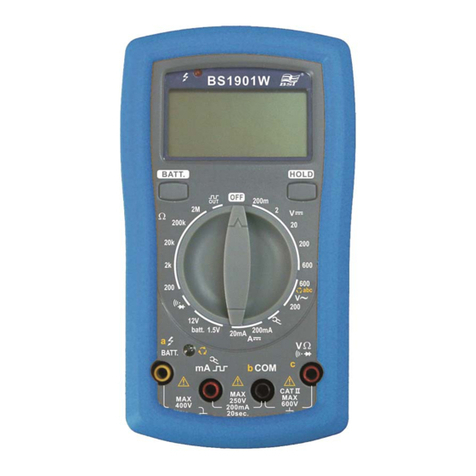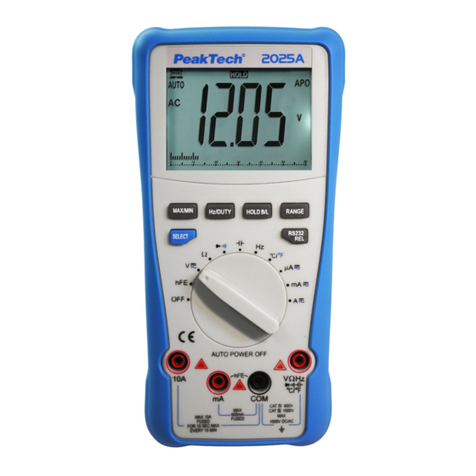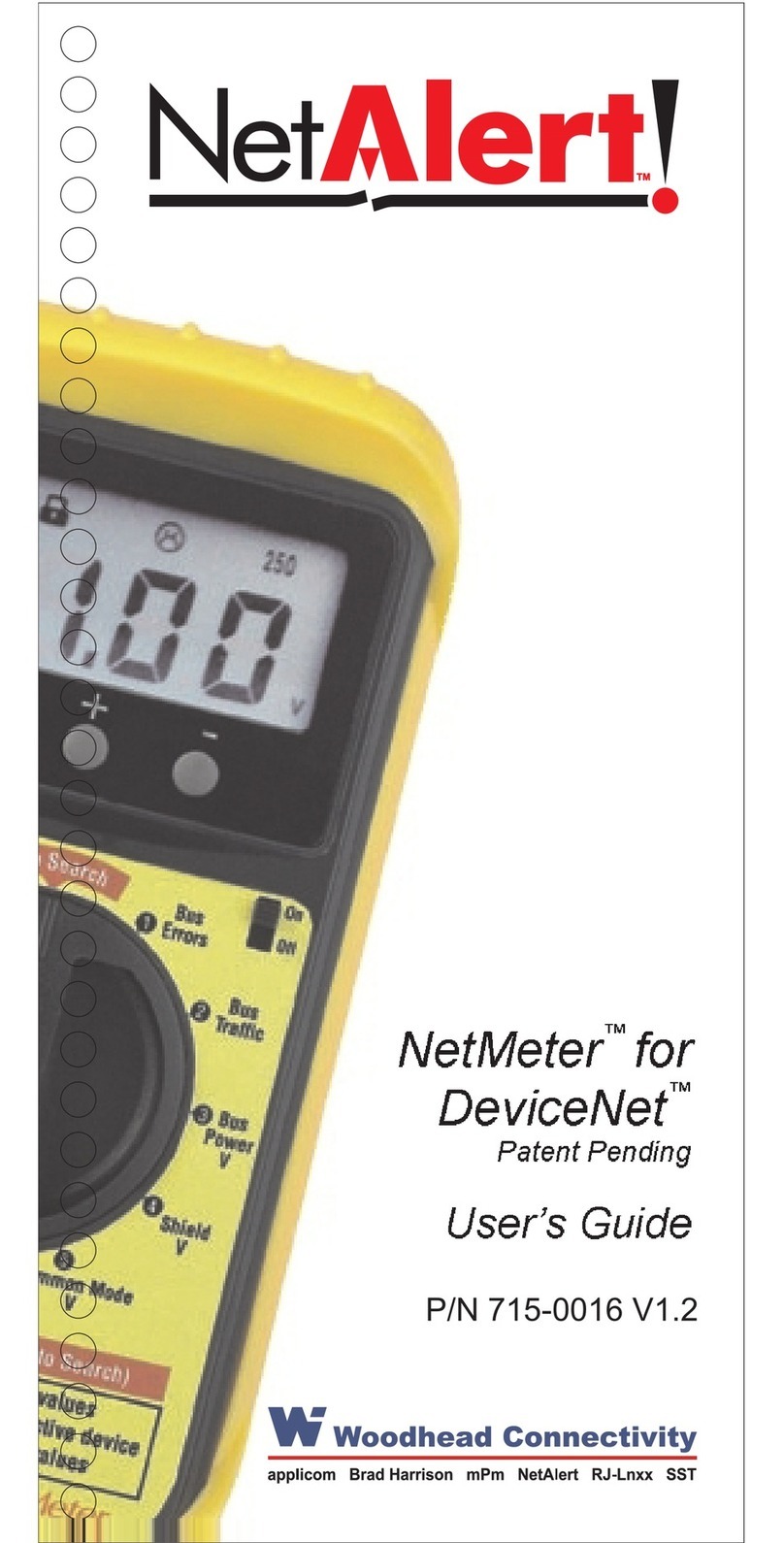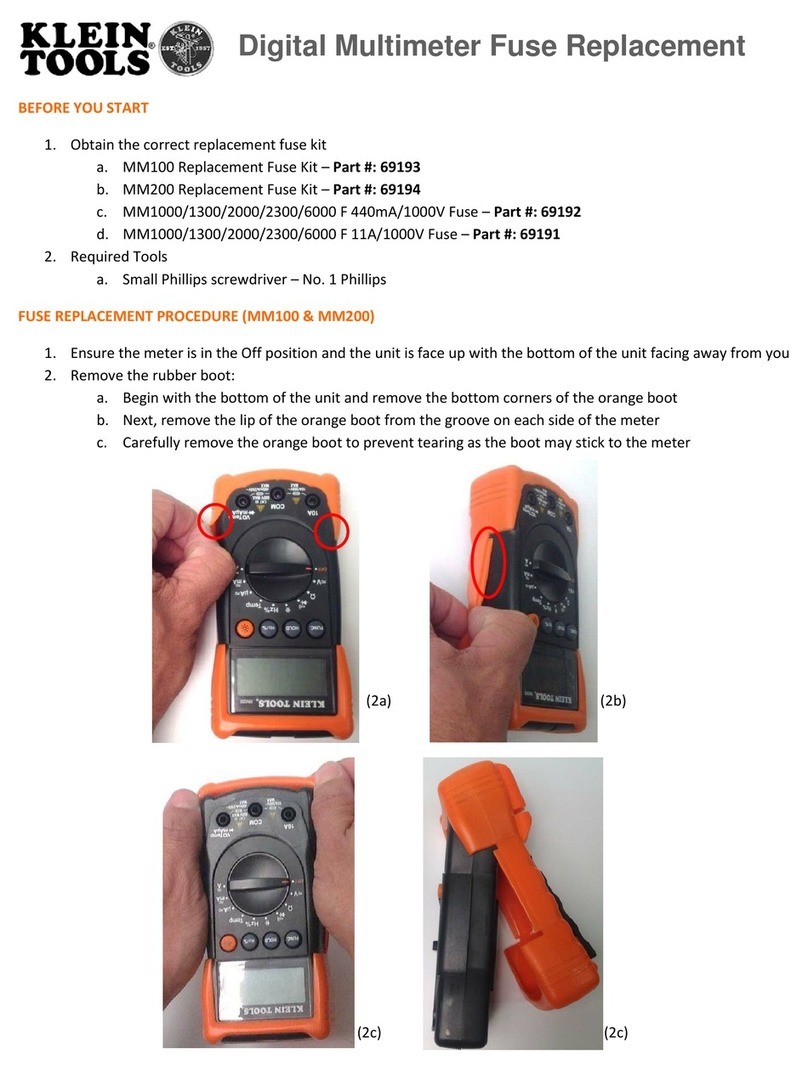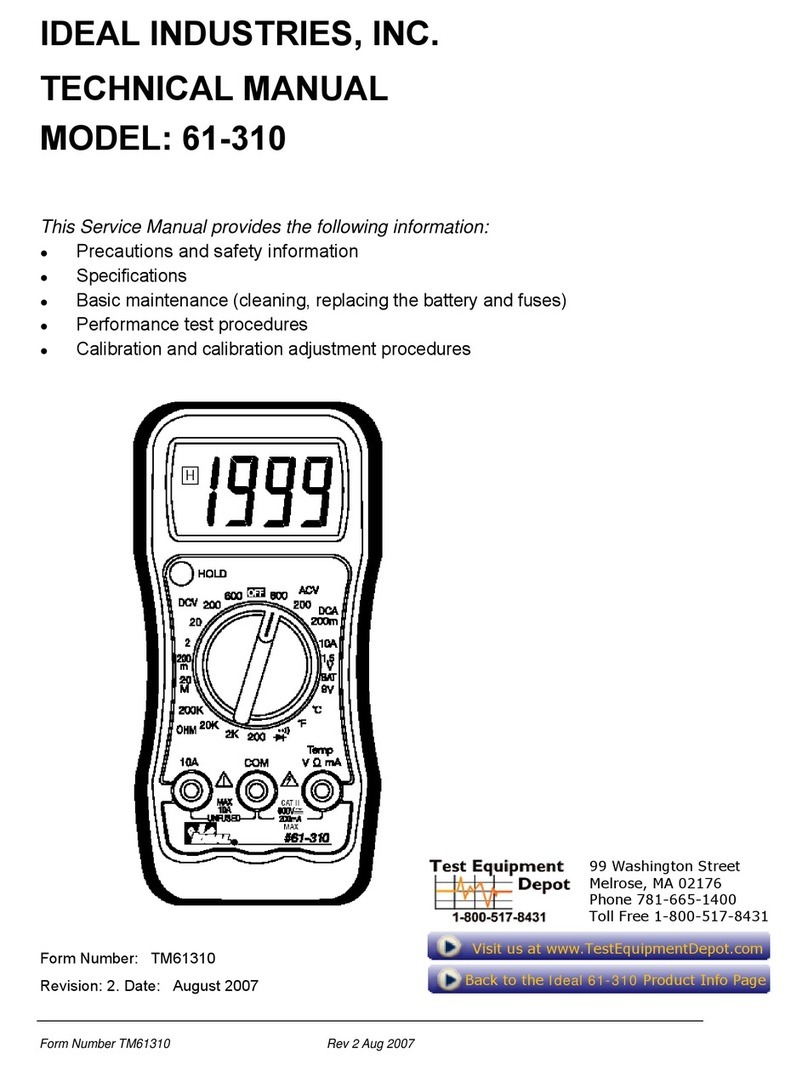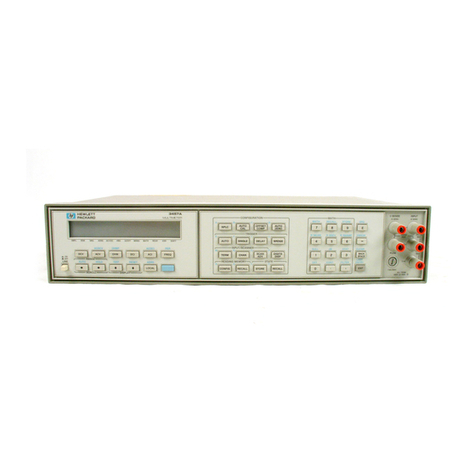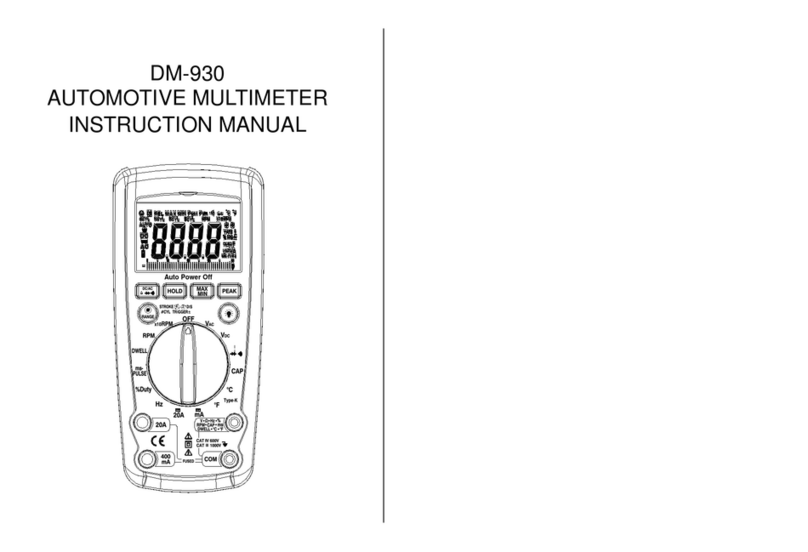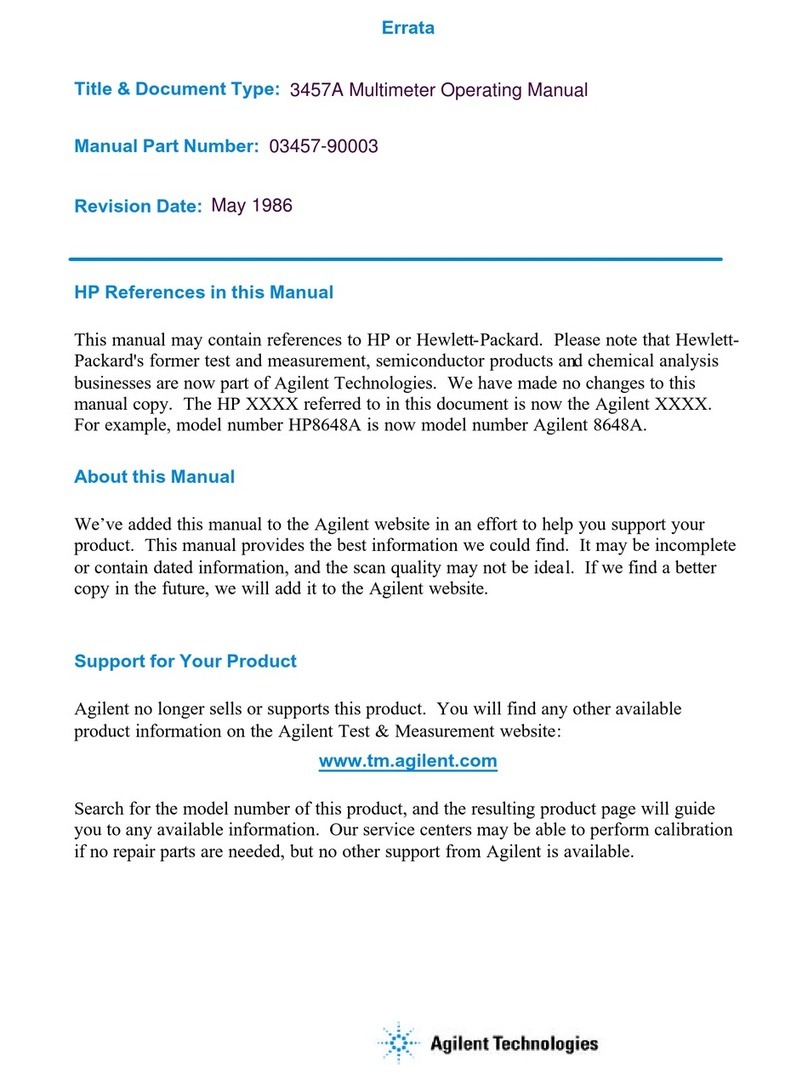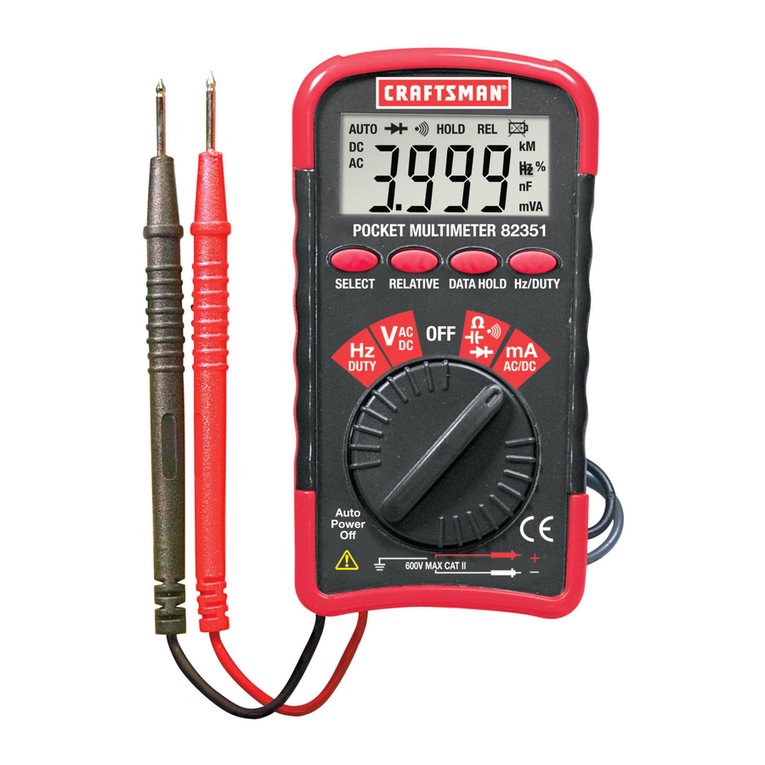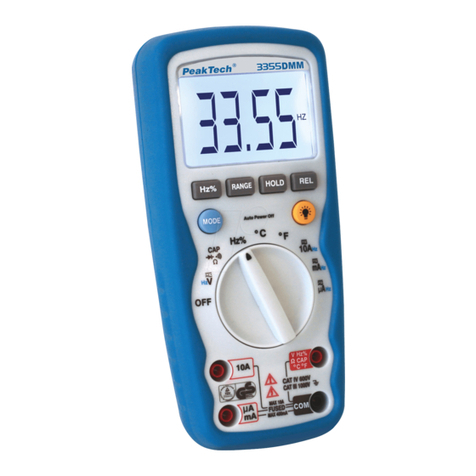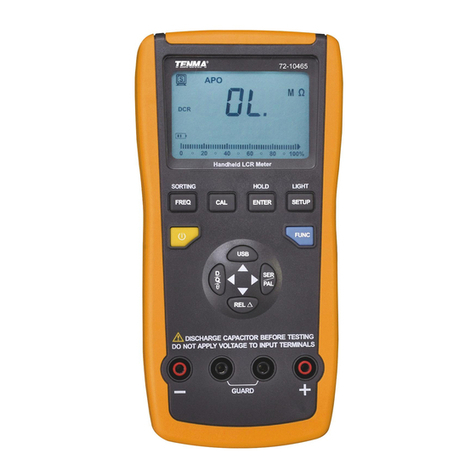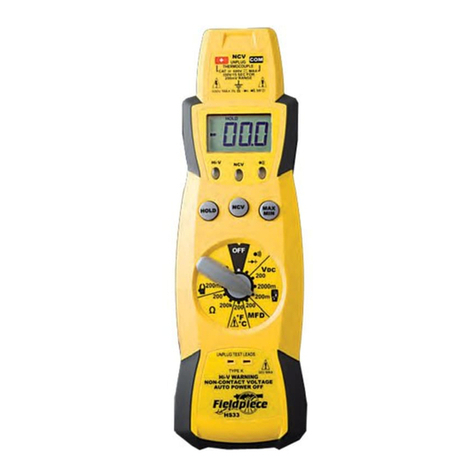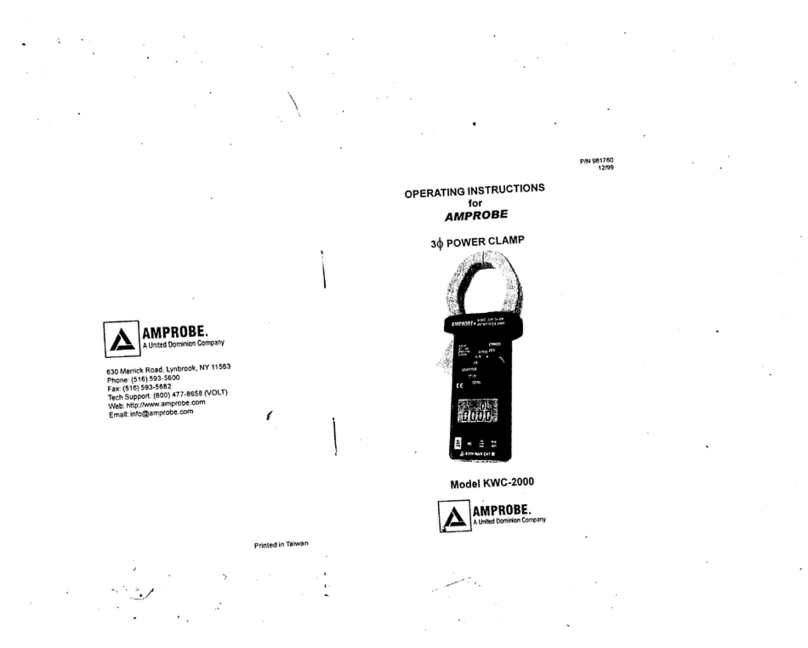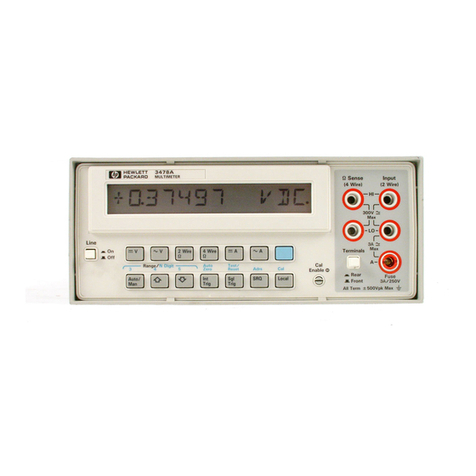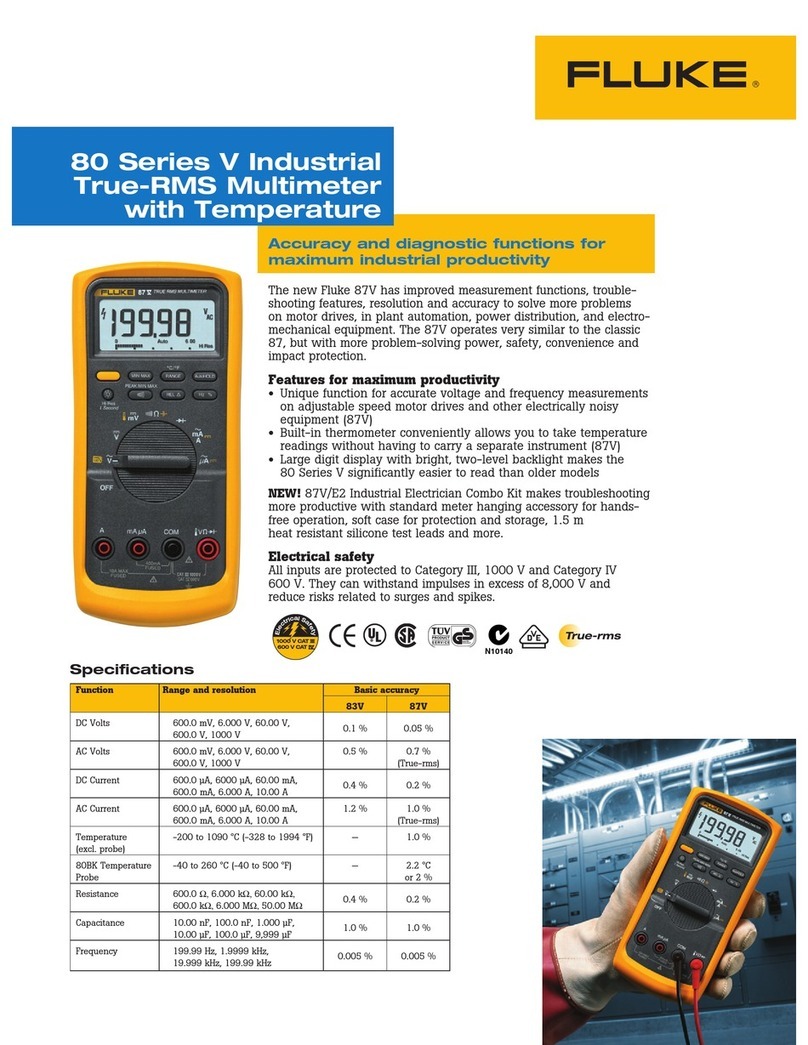BST CM3604 User manual

3 1/2 DIGIT DIGITAL MULTIMETER WITH
TRANSISTOR, FREQUENCY AND CAPACITANCE
OPERATION MANUAL
1. SAFETY RULES
This meter is designed and tested in accordance with EN publication 61010-1,
installation category II overvoltage 600V. and pollution degree 2.
This meter has been tested according to the following EMC Directives
89/336/EEC (EMC of Nov., 1992, Electromagnetic Compatibility)
73/23/EEC Product safety law of Low Voltage Directive, EN61010-1 (04,93)
This meter is designed to be indoor use at temperature 5C to 40C and altitude up to
2,000m.
To ensure that the meter is used safely, please follow all safety and operating
instructions in this operation manual. If the meter is not used as described in this
operation manual, the safety features of this meter might be impaired.
Do not use the meter when the meter or test lead looks damaged, or when you
suspect that the meter is not operating properly.
When using the probes, keep your fingers behind the finger guards on the probes.
Disconnect the live test lead before disconnecting the common test lead.
Make sure power is off before cutting, unsoldering, or breaking the circuit. Small
amount of current can be dangerous.
Do not apply more than 600Vdc or 600Vac rms between a terminal and earth ground.
To avoid electrical shock, use CAUTION when working above 60Vdc or 25Vac rms.
Such voltages pose a shock hazard.
Never make measurements with the battery cover or bottom case off.
To avoid electrical shock or damage to the meter, do not exceed the input limits.
2. INTERNATIONAL SYMBOLS
Important information
Diode
see manual
Continuity
AC
Ground
DC
Double insulation
3. SPECIFICATION
3.1 General Specifications
Display
:
3 1/2 digit LCD with maximum reading of 1999.
Polarity
:
Automatic, (-) negative polarity indication.
Zero adjustment
:
Automatic.
Over range indication
:
Only the massage “1” is displayed.
Power
:
Single, standard 9 volt battery NEDA 1604, JIS 006P,
IEC6F22.
Auto Power Off
:
Approximate 15 minutes. (Pressing twice the Power
Key to resume).
Dimension
:
94 (W) x 205 (H) x 62 (D) mm.
Weight
:
Approx. 620 g (including battery and packaging).
3.2 Electrical Specifications
Accuracies are (% of reading + no. of least significant digits) at 23C 5C, <75% RH.
DC Voltage
Range
Resolution
Accuracy
Input Impedance
Overload
Protection
200mV
0.1mV
(0.8% + 1)
10M
250V DC/AC rms
2V
0.001V
600V DC/AC rms
20V
0.01V
200V
0.1V
600V
1V
AC Voltage
Range
Resolution
Accuracy
Freq. Response
Input Impedance
10M
2V
0.001V
(0.8% + 3)
40-400Hz
Overload
Protection
600V DC/AC rms
20V
0.01V
200V
0.1V
600V
1V
(1.2% + 3)
On 2V range, if short nor open the two test leads, display reading is 10 digits, this
10 digits should not be subtracted from measurement results.
DC Current
Range
Resolution
Accuracy
Volt. drop
Overload
Protection
Fast 200mA/250V
Fused
2mA
0.001mA
(0.8% + 3)
200mV
20mA
0.01mA
200mA
0.1mA
(1.0% + 3)
20A
0.01A
(2.0% + 5)
15sec. Max. Unfused
AC Current
Range
Resolution
Accuracy
Volt.
drop
Freq.
Response
Overload Protection
20mA
0.01mA
(1.2% + 3)
200mV
40-400Hz
Fast 200mA/250V
Fused
200mA
0.1mA
(1.5% + 3)
20A
0.01A
(3.0% + 5)
15sec. Max. Unfused
Resistance
Range
Resolution
Accuracy
Open circuit volt.
200
0.1
(0.8% + 2)
<0.7V
Overload
Protection
250VDC/ACrms
<30sec
2k
0.001k
20k
0.01k
200k
0.1k
2M
0.001M
20M
0.01M
(1.0% + 2)
200M*
0.1M
(5.0% + 10)
<3V
On 200MΩrange, if short the two test leads, display reading is 10 digits, this 10
digits should be subtracted from measurement results.
Capacitance
Range
Resolution
Accuracy
Test Freq.
2nF
0.001nF
(2.5% + 5)
400Hz
20nF
0.01nF
200nF
0.1nF
2F
0.001F
20F
0.01F
On 2nF range, if Cx socket without DUT, display reading is 10 digits, this 10 digits
should not be subtracted from measurement results.
Frequency
Range
Resolution
Accuracy
Overload Protection
250VDC/ACrms<30sec
2kHz
0.001kHz
(1.5% + 5)
Vmin > 150mV
Vmax < 10V
20kHz
0.01kHz
Test voltage
Test current
Open circuit Volt.
Overload
Protection
250VDC/ACrms
<30sec
Approx. 2.8V
Approx. 1mA
2.8V
Range
Test current
Open circuit Volt.
Buzzer sounds when
resistance value
≤60
Approx.
1.0mA
2.8V
Transistor
Test
Range
hFE value
Test volt.(Vce)
Base current
hFE
0-1000
Approx. 2.8V
Approx. 10μA
4. PANEL DESCRIPTIONS
1) 3 1/2 digits LCD display
2) Power Key
3) Function selector
4) Rubber Holster
5) Hold Key
6) Transistor socket
7) Input and common socket
8) Capacitor socket
5. OPERATION
WARNING
1) When measuring voltage ensure that the instrument is not connected or switched to a
current or resistance or temperature or to the diode check/continuity range. Always
ensure that the correct terminals are used for the type of measurement to be made.
2) Use extreme care when measuring voltage above 50V, especially from sources where
high energy exists.
3) Avoid making connections to “live” circuits whenever possible.
4) When conducting current measurements ensure that the circuit is not “live” before
opening it in order to connect the test leads.
5) Before conducting resistance measurements or continuity / diode test, ensure that the
circuit under test is de-energised.
6) Always ensure that the correct function and range is selected. If in doubt about the
correct range, starts with the highest and works downwards.
7) Extreme care should be taken when using the instrument to conjunction with a current
transformer connected to the terminals. High voltage may be produced at the terminals if
an open circuit occurs.
8) Ensure that the test leads and probes are in good condition with no damage to the
insulation.
9) Take care not to exceed the over-load limits as given in the specifications.
10)Fuse for replacement must be of the correct type and rating.
5.1 DC and AC Voltage measurement
1) Connect the black test lead to the “COM” socket and red test lead to the “
V
kHz
” socket.
2) Set the function selector to “
V
” or “
V
” position to measure DCV or ACV.
3) Connect the test leads across the source or loads under measurement.
5.2 DC Current measurement
1) Connect the black test lead to the “COM” socket and red test lead to the “mA” socket for
measurement up to 200mA.
2) Set the function selector to desired resistance range “
A
” position.
3) Connect the test leads in series with the current source to be measured.
4) For current measurement from 200mA to 20A (Unfused) follow generally the above
procedure but connect the red test lead to “20A” socket.
5.3 AC Current measurement
1) Connect the black test lead to the “COM” socket and red test lead to the “mA” socket for
measurement up to 200mA.
2) Set the function selector to desired resistance range “
A
” position.
3) Connect the test leads in series with the current source to be measured.
4) For current measurement from 200mA to 20A (Unfused) follow generally the above
procedure but connect the red test lead to “20A” socket.
5.4 Resistance measurement
1) Connect the black test lead to the “COM” socket and red test lead to the “
V
kHz
” socket.
2) Set the function selector to desired resistance range position
3) Connect the leads across the circuit to be tested.
CAUTION: Ensure that the circuit to be tested is “dead”.
Maximum input over-load : 250V rms < 30sec.
5.5 Diode test
1) Connect the black test lead to the “COM” socket and red test lead to the “
V
kHz
” socket.
2) Set the function selector to (same as ) position.
3) Connect the black and red test leads to the cathode (-) and anode (+) ends of the diode
to be tested respectively.
4) Read the forward voltage drop (junction) value from the display. If reverse connected the
test leads to diode, display shows over-load.
5.6 Continuity test
1) Connect the black test lead to the “COM” socket and red test lead to the “
V
kHz
” socket.
2) Set the function selector to (same as ) position.
3) Connect the leads across the circuit to be tested, if the resistance less than or equal to
approx. 60, buzzer will be activated.
CAUTION: Ensure that the circuit to be tested is “dead”.
Maximum input over-load : 250V rms < 30sec.
5.7 Transistor hFE test
1) Set the function selector to “hFE”position.
2) Determine whether the transistor is of NPN or PNP type and locate the E, B and C leads.
insert the leads into the proper holes in the socket “
NPN
PNP
”on the front panel.
3) The display will read the approximate hFE value at the test condition of base current 10μ
!
!
!
1
2
3
4
5
6
7
8NPN
PNP
600V
MAX
Cx
20A COM
mA V
200m A MAX
FUSE D
20A 15 s ec. MA X
UNFU SED
MAX C ATI I
600V
kHz
Hz
20k 2k
20 F
20nF
2F
200nF
2nF
POWER HOLD
2V
20V
200V
600V
600V
20A 200mA 20mA
20A
2mA
20mA
200mA
A
A
V
200k 20k2M 2k
20M 200
200M
hFE
20V
2V
200mV
200V
V
AUTO POWER OFF
!

A, Vce 3.0V
5.8 Capacitance Measurement
1) Set the function selector to desired resistance range “ ” position.
2) Insert the capacitor into the capacitor “Cx” socket
!
CAUTION: Ensure that the capacitor to be tested is “de-energised”.
5.9 Frequency measurement
1) Connect the black test lead to the “COM” socket and red test lead to the “
V
kHz
” socket.
2) Set the function selector to desired frequency range “Hz” position.
CAUTION: Ensure that the circuit to be tested is “dead”.
Maximum input over-load : 250V rms < 30sec.
5.10 Data Hold
The hold key is used to hold data during measurement. Pressing the key, reading is held
and “ “ appears in the left side of the display. Pressing the key again to release the hold
function.
6. MAINTENANCE
CAUTION
BEFORE ATTEMPTING BATTERYAND FUSE REMOVAL OR REPLACEMENT,
DISCONNECT TEST LEADS FROM ANY ENERGISED CIRCUITS TO AVOID SHOCK
HAZARD.
6.1 Fitting and replacing the battery and fuse
1) Ensure that the instrument is not connected to any external circuit, set the function
selector to OFF position and remove the test leads from the terminals.
2) Remove the screw of the battery compartment on the bottom of the back case.
3) Replace the spent battery or fuse with the same type and rating.
4) Reinstate the battery compartment, tighten and securing screw.
6.2 Cleaning
Periodically wipe the case with a soft damp cloth and mild household cleanser. Do not use
abrasives or solvents. Ensure that no water gets inside the equipment to prevent possible
shorts and damage.
FOR TECHNICAL ASSISTANCE,
PLEASE CONTACT:
3604
REV4/JUL.03
!
!
Other BST Multimeter manuals

